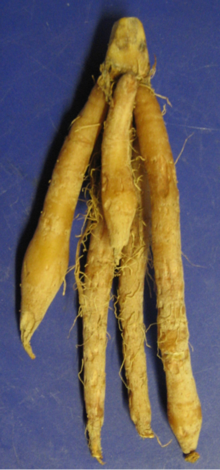Boesenbergia rotunda
This article includes a list of references, related reading, or external links, but its sources remain unclear because it lacks inline citations. (March 2013) |
| Boesenbergia rotunda | |
|---|---|

| |
| Scientific classification | |
| Kingdom: | |
| (unranked): | |
| (unranked): | |
| (unranked): | |
| Order: | |
| Family: | |
| Genus: | |
| Species: | B. rotunda
|
| Binomial name | |
| Boesenbergia rotunda | |
| Synonyms[1] | |
| |
Boesenbergia rotunda, commonly known as Chinese keys,[2] fingerroot, lesser galangal or Chinese ginger, is a medicinal and culinary herb from China and Southeast Asia. In English, the root has traditionally been called fingerroot, because the shape of the rhizome resembles that of fingers growing out of a center piece.
Uses
Fingerroot is known as temu kunci in Indonesian. It is widely used in Javanese cuisine in Indonesia.
In Thai cooking it is called krachai (Thai: กระชาย; pronounced [krà.tɕʰāːj]) and is an ingredient of dishes such as kaeng tai pla. It is used in some kroeung pastes of Cambodian cuisine and is known as k'cheay (Khmer: ខ្ជាយ). In the west it is usually found pickled or frozen. It is sometimes confused with Alpinia officinarum, another plant in the family Zingiberaceae which is also known as lesser galangal. In Meitei, it is called Yai-macha.
References
- ^ "The Plant List: A Working List of All Plant Species". Retrieved 25 January 2014.
- ^ "USDA GRIN Taxonomy".
External links
- Gernot Katzer's Spice Pages – Fingerroot
- "Boesenbergia rotunda". Integrated Taxonomic Information System.
